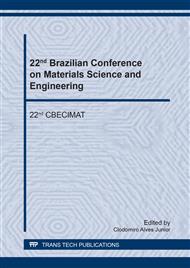p.416
p.422
p.428
p.434
p.440
p.445
p.449
p.454
p.460
Influence of Alloying Elements Zr, Nb and Mo on the Microstructure and Magnetic Properties of Sintered Pr-Fe-Co-B Based Permanent Magnets
Abstract:
The addition of alloying elements on rare-earth permanent magnets is one of the methods used to improve the magnetic properties. This present work evaluates the influence of alloying elements such as Zr, Nb and Mo on the microstructure and magnetic properties of sintered Pr-FeCo-B based permanent magnets. The permanent magnets were produced by the conventional powder metallurgy route using powder obtained by hydrogen-decrepitation (HD) method from as cast alloys. In order to produce the magnet Pr16Fe66,9Co10,7B5,7Cu0,7 without alloying elements the mixture of alloys method was employed, mixing two compositions: Pr20Fe73B5Cu2 (33% w.t) and Pr14Fe64Co16B6 (67% w.t). With the purpose of evaluating the influence of the alloying elements, the Pr14Fe64Co16B6X0,1 (where X= Zr, Nb or Mo) (67% w.t) alloy was employed. The characterization of the alloys and the magnets was carried out using scanning electron microscopy (SEM), energy-dispersive X-ray spectroscopy (EDXS) and the magnetic properties were measured using a permeameter. The magnet without any additions presented the highest intrinsic coercivity (μ0iHc = 748 KA.m-1) while the magnet with Nb addition presented higher remanence (Br = 1,04 T). The magnet with Zr addition presented the highest maximum energy product (BHmáx = 144 KJ.m-3), and the magnet with Mo addition showed the highest squareness factor (SF = 0,73).
Info:
Periodical:
Pages:
440-444
Citation:
Online since:
September 2018
Price:
Сopyright:
© 2018 Trans Tech Publications Ltd. All Rights Reserved
Share:
Citation:


